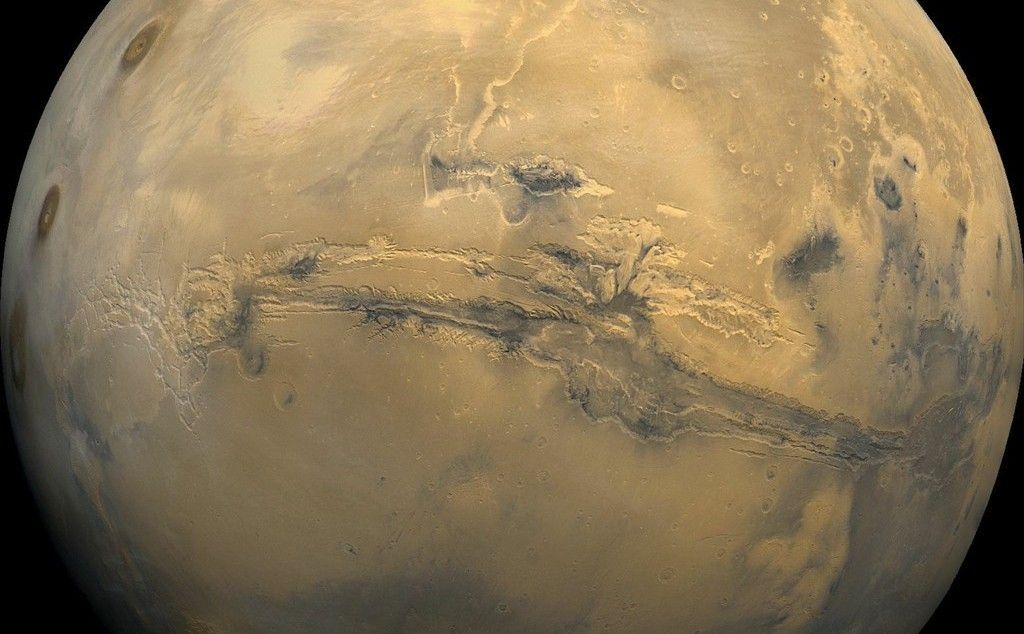After a decade of searching, NASA’s MAVEN (Mars Atmosphere Volatile Evolution) mission has, for the first time, reported a direct observation of an elusive atmospheric escape process called sputtering that could help answer longstanding questions about the history of water loss on Mars.
Scientists have known for a long time, through an abundance of evidence, that water was present on Mars’ surface billions of years ago, but are still asking the crucial question, “Where did the water go and why?”
Early on in Mars’ history, the atmosphere of the Red Planet lost its magnetic field, and its atmosphere became directly exposed to the solar wind and solar storms. As the atmosphere began to erode, liquid water was no longer stable on the surface, so much of it escaped to space. But how did this once thick atmosphere get stripped away? Sputtering could explain it.
Sputtering is an atmospheric escape process in which atoms are knocked out of the atmosphere by energetic charge particles.
“It’s like doing a cannonball in a pool,” said Shannon Curry, principal investigator of MAVEN at the Laboratory for Atmospheric and Space Physics at the University of Colorado Boulder and lead author of the study. “The cannonball, in this case, is the heavy ions crashing into the atmosphere really fast and splashing neutral atoms and molecules out.”
While scientists had previously found traces of evidence that this process was happening, they had never observed the process directly. The previous evidence came from looking at lighter and heavier isotopes of argon in the upper atmosphere of Mars. Lighter isotopes sit higher in the atmosphere than their heavier counterparts, and it was found that there were far fewer lighter isotopes than heavy argon isotopes in the Martian atmosphere. These lighter isotopes can only be removed by sputtering.
“It is like we found the ashes from a campfire,” said Curry. “But we wanted to see the actual fire, in this case sputtering, directly.”
To observe sputtering, the team needed simultaneous measurements in the right place at the right time from three instruments aboard the MAVEN spacecraft: the Solar Wind Ion Analyzer, the Magnetometer, and the Neutral Gas and Ion Mass Spectrometer. Additionally, the team needed measurements across the dayside and the nightside of the planet at low altitudes, which takes years to observe.
The combination of data from these instruments allowed scientists to make a new kind of map of sputtered argon in relation to the solar wind. This map revealed the presence of argon at high altitudes in the exact locations that the energetic particles crashed into the atmosphere and splashed out argon, showing sputtering in real time. The researchers also found that this process is happening at a rate four times higher than previously predicted and that this rate increases during solar storms.
The direct observation of sputtering confirms that the process was a primary source of atmospheric loss in Mars’ early history when the Sun’s activity was much stronger.
“These results establish sputtering’s role in the loss of Mars’ atmosphere and in determining the history of water on Mars,” said Curry.
The finding, published this week in Science Advances, is critical to scientists’ understanding of the conditions that allowed liquid water to exist on the Martian surface, and the implications that it has for habitability billions of years ago.
The MAVEN mission is part of NASA’s Mars Exploration Program portfolio. MAVEN’s principal investigator is based at the Laboratory for Atmospheric and Space Physics (LASP) at the University of Colorado Boulder, which is also responsible for managing science operations and public outreach and communications. NASA’s Goddard Space Flight Center in Greenbelt, Maryland, manages the MAVEN mission. Lockheed Martin Space built the spacecraft and is responsible for mission operations. NASA’s Jet Propulsion Laboratory in Southern California provides navigation and Deep Space Network support.
More information on NASA’s MAVEN missionBy Willow ReedLaboratory for Atmospheric and Space Physics, University of Colorado Boulder
Media Contacts:
Nancy N. JonesNASA’s Goddard Space Flight Center, Greenbelt, Md.
Karen Fox / Molly WasserHeadquarters, [email protected] / [email protected]
[email protected] / [email protected]
Share
Details
Last Updated May 28, 2025Related Terms
MAVEN (Mars Atmosphere and Volatile EvolutioN) Mars Planets Read More Details
Finally We wish PressBee provided you with enough information of ( NASA’s MAVEN Makes First Observation of Atmospheric Sputtering at Mars )
Also on site :
- Chipotle is Giving Away Free Burritos for An Entire Year—Here's How to Win
- Drowning’s the No. 1 killer of young children — from Orange to Pasadena, experts are trying to change that
- 'Top Chef' Season 22 Episode 12 Elimination Results: Who Was Sent Home This Week?

